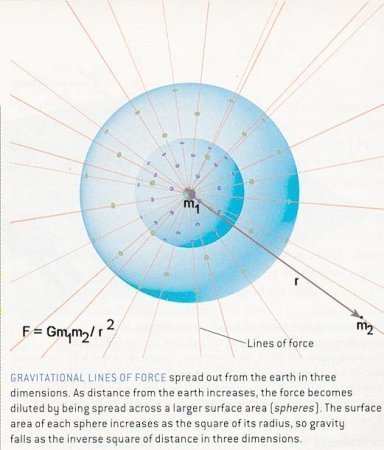

 |
 |
3-D wall in the extra dimensions. The Large Hadron Collider (LHC) (at CERN, to be completed by 2007) should observe strong quantum gravitational effects; for example, the high-energy particle beam at the LHC can cool by boiling off gravitons into the extra dimensions. More exotic gravitational objects, such as small black holes, can also be produced at the TeV energies available with LHC. In fact the LHC now becomes a quantum-gravity machine, which can look into these extra dimensions of space through apparent violations of energy conservation, as well as the appearance and disappearance of particles from extra dimensions. |
Figure 01 Gravitational Force [view large image] |
Figure 02 Coupling Strength [view large image] |
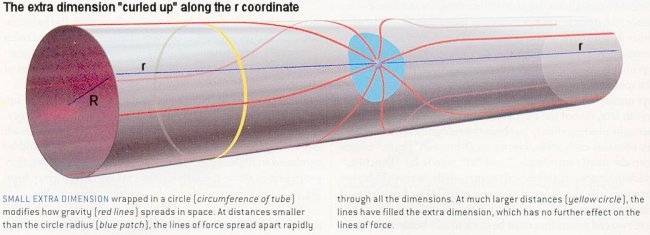 |
Starting from the source, the lines of force spread apart rapidly through all the dimensions. At distance larger than R, the force lines have filled the extra dimensions, which then cease to exert further influence (see Figure 03). Consequently, we can equate Eq. (1) and (2) at the distance R and obtain: |
Figure 03 Extra-dimension [view large image] |
 = 1 and c = 1, the gravitational constant has the dimensions of square centimeters. Thus, we can express
= 1 and c = 1, the gravitational constant has the dimensions of square centimeters. Thus, we can express | # of Extra Dimensions n | Curled-up Size R (cm) | Comments |
|---|---|---|
| 0 | Infinity | No extra dimension |
| 1 | 1015 | ~ Size of the Solar system |
| 2 | 0.1 | At detectable limit |
| 6 | 2.15x10-12 | Upper limit for the # of extra dimensions in superstring theory |
| Infinity | 10-17 | Infinite # of extra dimensions |
| # of Extra Dimensions n | Interaction Strength k (cm) | Comments |
|---|---|---|
| 0 | 10-33 | No extra dimension |
| 1 | 0.46x10-22 | In the middle of the "energy desert" |
| 2 | 10-17 | Electroweak interaction scale at TeV |
| 3 | 0.16x10-13 | Strong interaction scale at GeV |
| 6 | 10-9 | Upper limit for the # of extra dimensions in superstring theory ~ electromagnetic interaction in atomic scale |
| Infinity | 10-1 | Infinite # of extra dimensions |
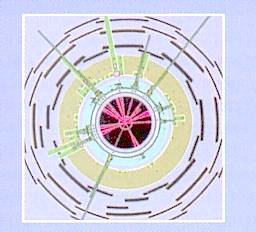 |
Thus, a black hole can be created with such energy packed into the corresponding length scale. These mini black hole will evaporate in 10-88 seconds, losing most of its mass by Hawking radiation. It is estimated that the final burst should radiate a large number of particles in all directions with very high energies. The decay products include all the particle species in nature. The LHC could provide the first evidence for Hawking radiation from such signatures of the black holes. Figure 04a depicts the simulated decay of a black hole inside a particle detector. From the center of the accelerator pipe (black circle) emerge particles (spokes) registered by layers of detectors (concentric colored rings). The sequence from birth to death of a mini black hole with an initial mass of 10 Tev is shown schematically in Figure 04b. It is created by the collision of two energetic particles (a). The scenario suggests that it will emit gravitational and electromagnetic waves as it settles |
Figure 04a Black Hole, Simulation [view large image] |
down. It becomes an almost featureless body, characterized solely by charge, spin and mass (b). Even the charge quickly leaks away as the black hole gives off charged particles. At first, the black hole emission comes at the expense of spin (c), so it slows down and |
 |
relaxes into a spherical shape, which is characterized solely by its mass (d). Finally, the mass bursts away in the form of radiation and massive particles (e). The remnant of the black hole approaches the Planck mass and disappears into nothingness. |
Figure 04b Black Hole, Evaporation [view large image] |
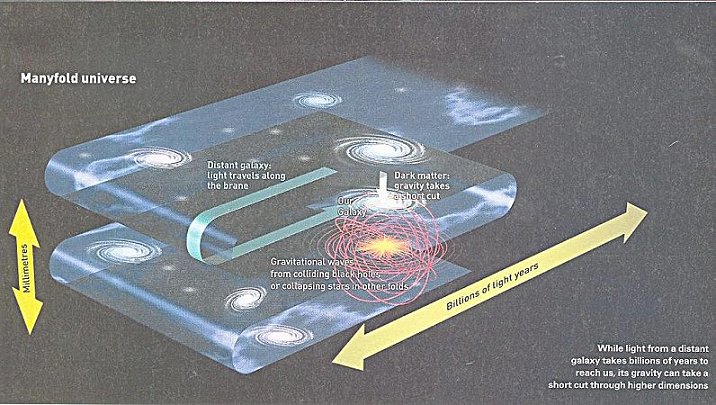 |
Superstring theory predicts the universe has ten or eleven dimensions. Why don't we see these extra dimensions? Perhaps we are living on a brane (short for membrane) - floating in a space of five, six or more dimensions, like a soap bubble in the bathroom. The "manyfold universe" theory asserts that the brane we live on could be folded over on itself many times, accordion-fashion (Figure 05). Light could travel only on the brane, but gravity could take a shortcut by jumping from one fold to the next. Nearby matter on other folds can be detected gravitationally as unseen dark matter, since its emitting light takes a long time to reach us traveling around the fold (see Figure 05). |
Figure 05 Manyfold Universe [view large image] |
 |
The concept of branes floating in higher dimensional space has offered some new ideas about condition at the moment of Big Bang and further back to the time before the event (see Figure 08). According to general relativity, density and temperature become infinity at the moment of Big Bang. The nonzero size and novel symmetries of strings set upper bounds to physical quantities that increase without limit in conventional theories, and they set lower bounds to quantities that decrease. The string theory expects that the curvature of space-time increase as the history of the universe is re-winded backward in time. But instead of going all the way to infinity, it eventually hits a maximum and shrinks once more (see Figure 06). The string theory also proposes some hazarded guesses about the pre-bang universe. There are two popular models floating around - the Pre-Big Bang and the Ekpyrotic scenarios. |
Figure 06 Two Views of the Big Bang |
 |
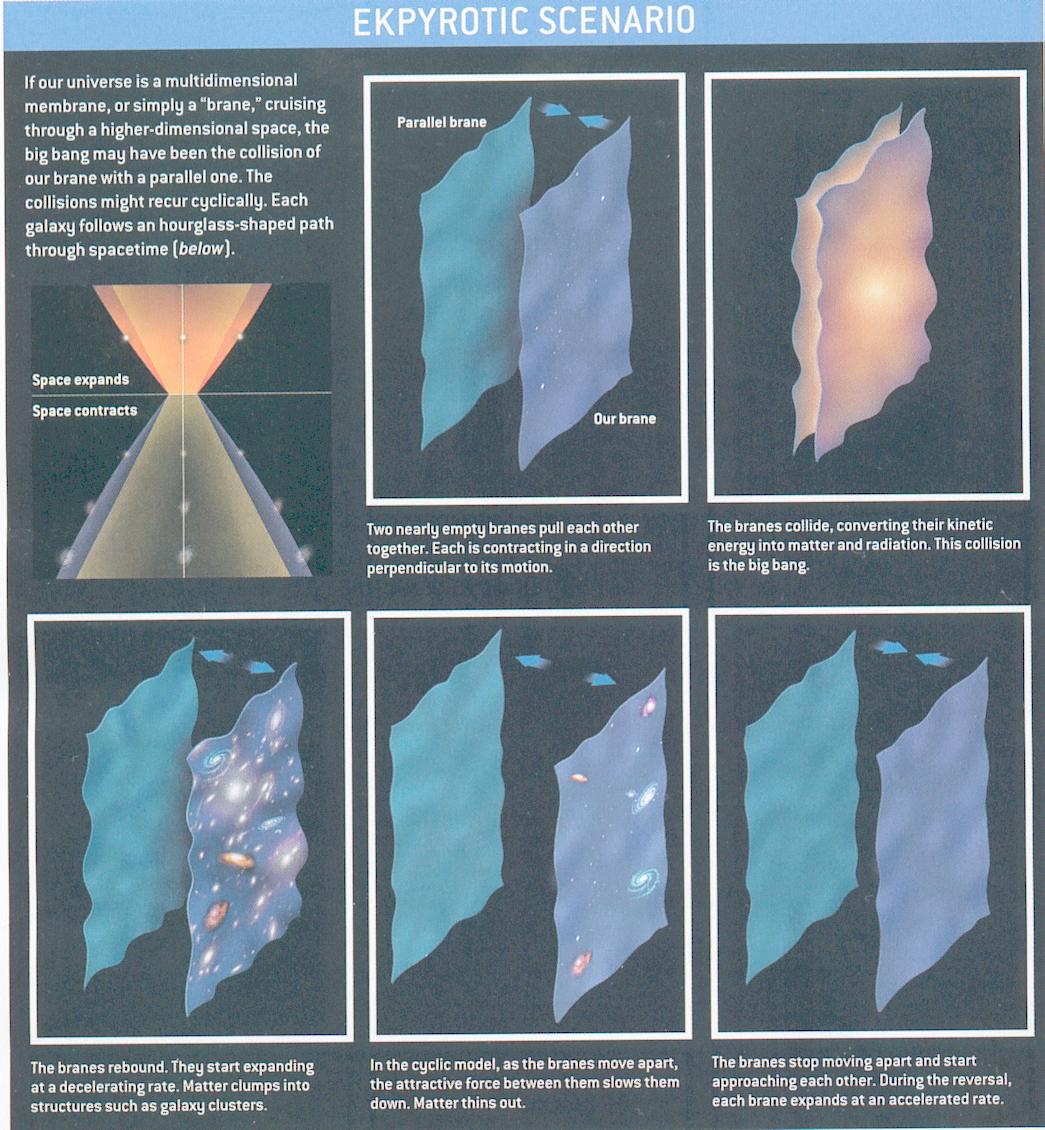 |
The Pre-Big Bang model was developed in 1991 by combining T-duality with the symmetry of time reversal. The combination gives rise to a cosmological model in which there was a period of acceleration before the Big Bang and then the deceleration. The Big Bang was simply a violent transition from on phase to another (see Figure 07). The other model is the Ekpyrotic (conflagration) scenario. It relies on the idea that our universe is one of many D-branes floating within a higher-dimensional space. The branes exert attractive forces on one another and occasionally collide. The Big Bang could be the impact of another brane into ours as shown in Figure 08. |
Figure 07 Pre-BB [view large image] |
Figure 08 Ekpyrotic Model |